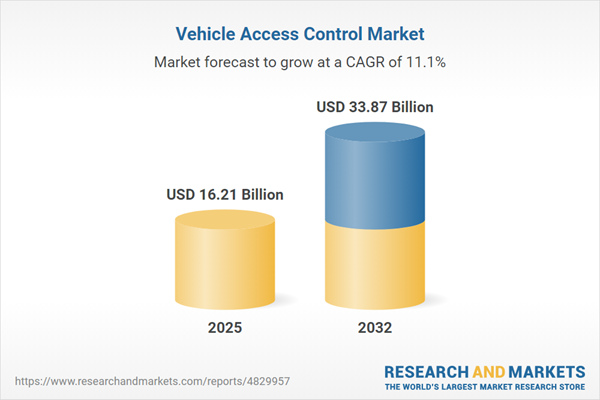Speak directly to the analyst to clarify any post sales queries you may have.
Senior leaders are reshaping fleet security priorities as the vehicle access control market transforms, compelled by changing regulations, significant technological advancements, and rising operational complexity. Organizations across industries now require solutions offering robust security, seamless compliance, and flexible scalability.
Market Snapshot: Vehicle Access Control Market
The global vehicle access control market is set for sustained expansion, increasing from USD 14.61 billion in 2024 to USD 16.21 billion by 2025, with projections reaching USD 33.87 billion by 2032. This growth is fueled by enterprise investments addressing evolving mobility standards and the heightened sophistication of fleet management. Biometric authentication, enhanced security protocols, and mobile integrations are transforming vehicle access methods, supporting the digitization of operations and compliance with shifting industry regulations. As expectations rise, senior executives are proactively adopting forward-thinking frameworks and prioritizing solutions that deliver both operational agility and strategic risk management. These developments are essential for organizations aiming to maintain competitiveness and resilience in a rapidly changing ecosystem.
Scope & Segmentation: Strategic Insights Across the Vehicle Access Control Landscape
This report equips decision-makers with intelligence vital for optimizing fleet operations and managing emerging risks across diverse markets.
- Access Technology: Evaluates biometric authentication, RFID technology, proximity sensors, and mobile-based credentialing to inform choices for secure and contactless vehicle entry suited to individual operational demands.
- Component Type: Explores a range of access modules, from network-integrated systems and standalone devices to ignition interfaces and advanced locking components, designed for scalability and adaptability throughout distributed fleets.
- Lock Type: Considers both electronic and mechanical locking mechanisms, emphasizing options that align with targeted security requirements and regulatory standards for various vehicle categories.
- Vehicle Type: Addresses the challenges associated with managing access for passenger vehicles, commercial fleets, off-road assets, and two-wheeler units, with recommendations tailored for logistics, public transit, and industrial sector managers.
- End User: Analyzes the needs of OEMs and aftermarket integrators, offering guidance on the integration of both embedded and retrofit access solutions to accommodate evolving fleet profiles.
- Regions Covered: Provides insights into regulatory trends and market dynamics across the Americas, Europe, Middle East & Africa, and Asia-Pacific, with specific intelligence covering major economies including the United States, China, Germany, India, Brazil, and South Africa.
- Company Analysis: Reviews strategies and product offerings from leading vendors including Bosch, Continental AG, DENSO, Valeo, Magna, Harman International, Aptiv, ZF Friedrichshafen, Aisin Seiki, and Visteon, highlighting their approaches to technological innovation and differentiation.
Key Takeaways: Strategic Insights for Executives
- Digital and wireless vehicle access technologies drive consistent authentication practices, providing improved oversight across wide-ranging fleet environments and supporting centralized asset management.
- Cloud-based management platforms simplify the integration of new vehicles and scale fleet deployment in line with organizational and market shifts, helping businesses stay flexible and responsive.
- Integrating IoT-enabled access systems introduces new security requirements, necessitating regular reviews and updates to legacy infrastructure as fleets expand and operational complexity increases.
- Customizable access control frameworks facilitate compliance with changing regulations and support diverse infrastructure needs across industries and geographies.
- Updating older fleet assets with modern mechanical and electronic access solutions extends asset life and reduces operational disruption during system upgrades or transitions.
- Cross-sector collaboration among solution providers, security specialists, and manufacturers drives continuous improvement, ensuring deployed technologies align with evolving industry standards and compliance expectations.
Tariff Impact: Navigating Trade Shifts and Production Incentives
Recent tariff increases in the United States affecting vehicle access control components have caused organizations to reexamine procurement and production models. By prioritizing regional sourcing and nearshoring, companies are improving cost efficiency, regulatory compliance, and the stability of their supply chains. As global trade dynamics shift, these strategies are bolstering the reliability of value chains and supporting the adoption of the latest access control innovations.
Methodology & Data Sources
Research findings are based on executive interviews across the automotive, technology, and security sectors, in conjunction with comprehensive analyses of industry publications, regulatory guidance, and patent literature. This approach ensures that recommendations reflect real-world practices and support informed, strategic decision-making for leadership teams.
Why This Report Matters
- Provides practical frameworks empowering executives to implement robust, adaptable vehicle access management programs that align with regulatory and digital transformation demands.
- Enables confident vendor selection and resource planning through thorough market segmentation, benchmarking, and transparent reviews of both security protocols and leading suppliers.
- Supports decision-makers in meeting compliance requirements and technological integration needs across regional and global fleet operations.
Conclusion
This report delivers senior leaders actionable guidance for implementing advanced vehicle access technologies, navigating compliance demands, and boosting fleet efficiency during industry transition. Leverage these strategic insights to strengthen your fleet’s security and operational capabilities.
Additional Product Information:
- Purchase of this report includes 1 year online access with quarterly updates.
- This report can be updated on request. Please contact our Customer Experience team using the Ask a Question widget on our website.
Table of Contents
3. Executive Summary
4. Market Overview
7. Cumulative Impact of Artificial Intelligence 2025
Companies Mentioned
The companies profiled in this Vehicle Access Control market report include:- Robert Bosch GmbH
- Continental AG
- DENSO Corporation
- Valeo S.A.
- Magna International Inc.
- Harman International Industries, Incorporated
- Aptiv PLC
- ZF Friedrichshafen AG
- Aisin Seiki Co., Ltd.
- Visteon Corporation
Table Information
| Report Attribute | Details |
|---|---|
| No. of Pages | 196 |
| Published | October 2025 |
| Forecast Period | 2025 - 2032 |
| Estimated Market Value ( USD | $ 16.21 Billion |
| Forecasted Market Value ( USD | $ 33.87 Billion |
| Compound Annual Growth Rate | 11.0% |
| Regions Covered | Global |
| No. of Companies Mentioned | 11 |









